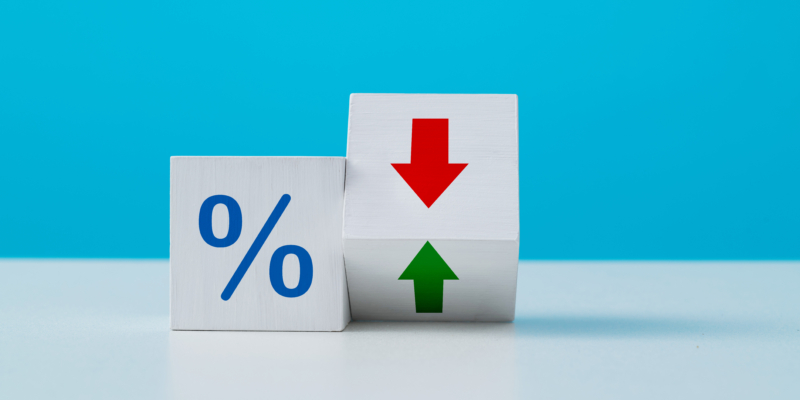Understanding Mortgage Interest Rates
House hunting is exhilarating, but when it comes to mortgages, it can be daunting. Understanding mortgage rates: a complete guide is key to navigating this process effectively.
Don’t fret – we’re here to demystify mortgage rates for you, whether you’re buying or refinancing. Our goal is to empower you to compare loan rates and make informed financial decisions.
Firstly, how does mortgage interest work?
Mortgage rates determine the cost of borrowing money from a lender. They impact how much interest you’ll pay over the mortgage’s lifespan, alongside your principal payments. Note that interest rates do not include additional fees or charges; for a comprehensive view, consider the APR (annual percentage rate), which covers these costs but doesn’t affect your monthly payments.
What factors determine mortgage rates?
Mortgage rates fluctuate based on market conditions, influenced by economic indicators and the Federal Reserve’s policies. The type and term of your loan also play roles, as does your individual financial profile. Explore different scenarios with our mortgage comparison calculator to see how mortgage rates affect monthly payments and total costs.
Lenders will look at things like:
- Your income and employment history
- Your down payment amount. Typically, if you pay more up front, you may get a lower rate.
- Your desired loan amount
- Loan-to-value ratios. How does the amount of the mortgage compare to the appraised value of the property?
- Your credit worthiness, including your credit score, and repayment history. Are you a lower-risk borrower who will likely pay the loan back in full? Or are you high-risk based on your loan repayment history and more likely to miss making monthly loan payments?
- Your cash reserves and personal financial assets
- Your levels of outstanding debt in relation to your income levels, known as debt-to-income ratio
- Whether you’re purchasing a home or refinancing an existing mortgage
- The property and occupancy type
- Property location, including state and county
- Loan term. Shorter-term loans have lower rates but higher monthly payments because you’re paying off the principal balance over a shorter period of time
How can I get a rate quote?
You can obtain a rate quote in minutes at AmeriSave.com. From the homepage, go to the “Get Rates” box on the homepage, enter your information, and get rate quotes specific to the criteria you enter. Please be sure that you have entered your information correctly, as our rates are driven by many different factors. Click the “Next” button to the rate and terms that you desire. You can get your quoted rate and preapproval for credit in just three minutes! Alternatively, you can choose to talk to one of our experienced mortgage bankers and they can just as easily provide you with a rate quote.
AmeriSave provides multiple rate and payment options, one of the many things our customers appreciate about us. Published mortgage rates are updated as quickly as possible, based on market changes, and we provide all of the rates and options available to us for that day at the time of your search. This allows you to decide what rate or cost option works best for your personal financial needs.
AmeriSave.com also allows you to compare our rates to other quotes you have received. But you’ll find that AmeriSave’s rates and costs are comparably lower than others and considerably lower than the national average. This is because we are a company built on sophisticated technology. The AmeriSave business model is based on flexibility and lower overhead, allowing us to pass along substantial savings to our borrowers in the form of competitive rates and fees.
How can I get the best interest rate?
Even though AmeriSave offers low mortgage rate options, it’s always wise to compare rates from multiple mortgage lenders and loan offers. Make sure you grab a cup of coffee and carefully read over the full loan estimate (which includes closing costs) from each lender so that you fully understand all the calculations that are part of each estimate. It’s also helpful if you keep an eye on daily mortgage rates yourself; they fluctuate frequently, so you’ll want to stay in tune with them until you’re ready to lock. Rate lock guarantees your interest rate and holds it for a specific period of time until your closing.
Another way to lower your rate is to consider paying points. Discount points are a form of prepaid interest, a type of fee that you pay at closing to lower the interest rate for the term of the loan. One point is equal to 1% of the total loan balance, so if you want to purchase one point on a $300,000 loan, you’ll pay $3000. You need to think through how long you plan to stay in your home and how long it will take you to replenish the costs of the points you purchase. The longer you plan to stay, the more it’s worth considering paying points to lower your interest rate. As you calculate the numbers, compare what you’ll pay each month by paying points versus not paying points. This decision is unique to each borrower and something you should talk through with your mortgage banker.
You may want to checkout some useful tools and resources from the CFPB (Consumer Financial Protection Bureau) when you are shopping and exploring interest rates. Additionally, the FDIC (Federal Deposit Insurance Corporation) – an independent agency created by the United States Congress – provides useful resources including tips for getting the best mortgage.
Basic rate types: Fixed-rate and adjustable-rate
When considering how long you plan to stay in your home, understanding the basic types of mortgage rates is crucial.
A fixed-rate mortgage keeps your interest rate constant throughout the loan term, ensuring consistent monthly payments and the mortgage being fully paid off by the end (e.g., 15 years, 30 years, etc.). On the other hand, an adjustable-rate mortgage (ARM) starts with a fixed rate for a specified initial period (e.g., 5 years, 10 years, etc.), after which the rate adjusts periodically. This adjustment impacts your monthly payment, with limits on how high the rate can rise post-initial period.
If you anticipate moving within a few years, an ARM might be advantageous due to lower initial rates. Conversely, for long-term homeownership, a fixed-rate mortgage provides stability. Consult with our mortgage bankers to explore various scenarios and decide on the best option tailored to your financial goals. We’re committed to helping you make informed decisions about mortgage rates and terms.

 AmeriSave Mortgage Corporation
AmeriSave Mortgage Corporation AmeriSave Mortgage
AmeriSave Mortgage AmeriSave Mortgage
AmeriSave Mortgage AmeriSave Mortgage Corporation
AmeriSave Mortgage Corporation AmeriSave Mortgage
AmeriSave Mortgage AmeriSave Mortgage
AmeriSave Mortgage AmeriSave Mortgage
AmeriSave Mortgage